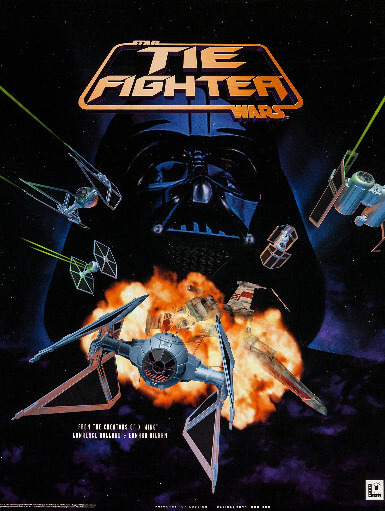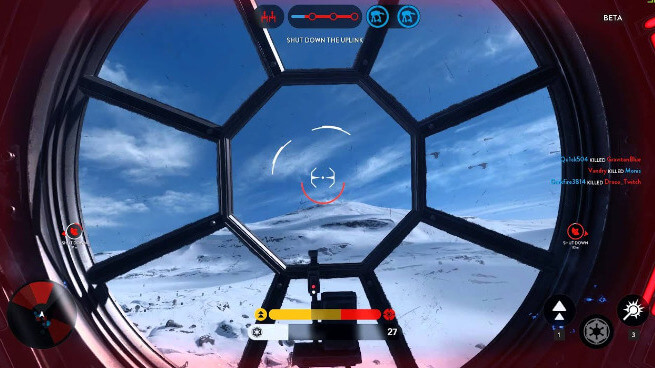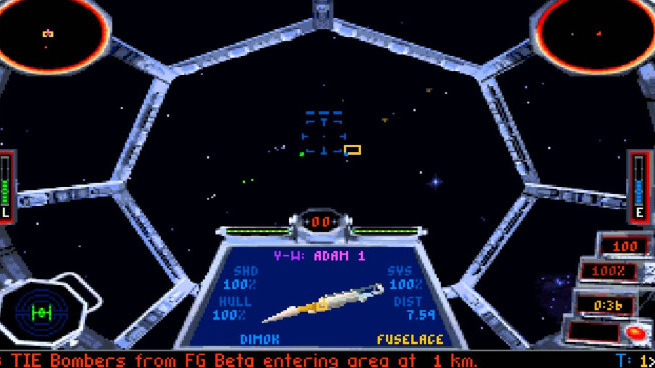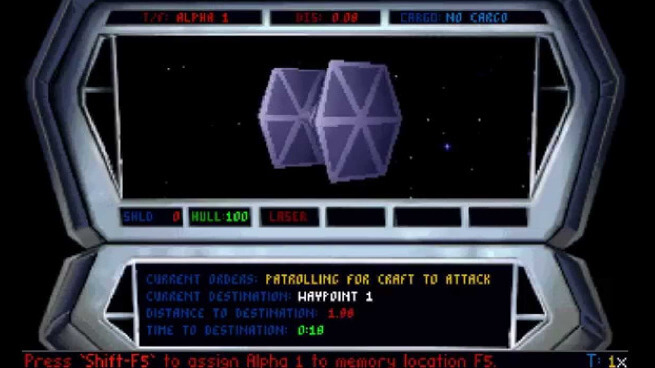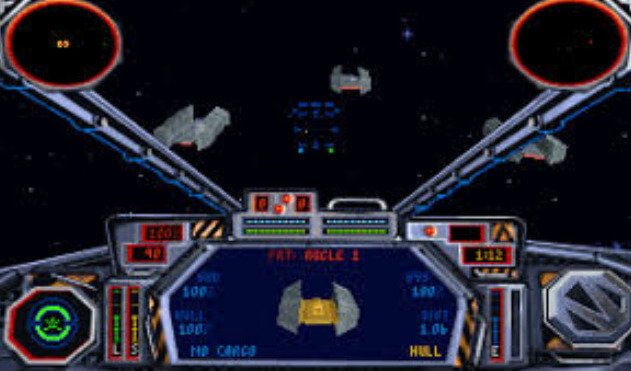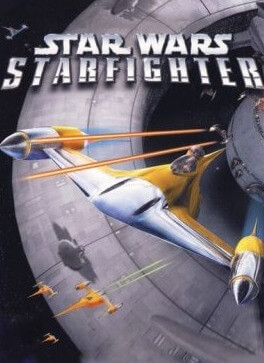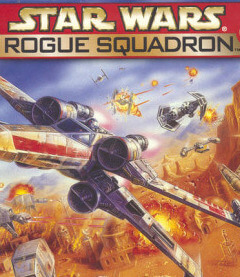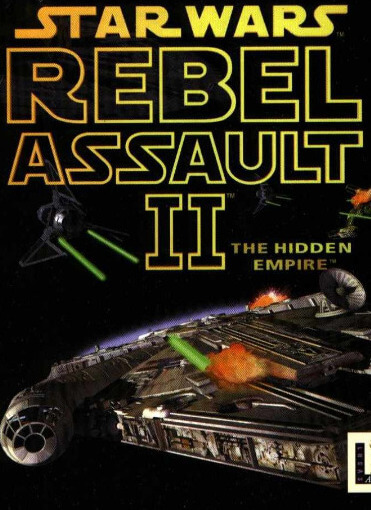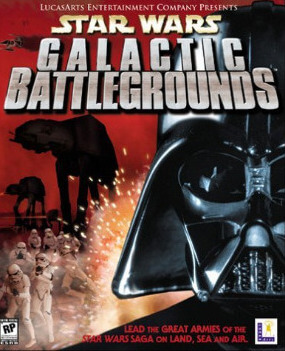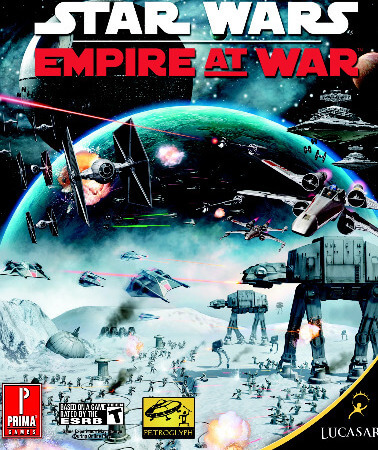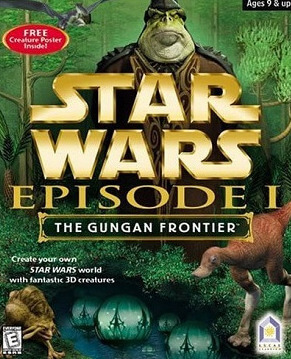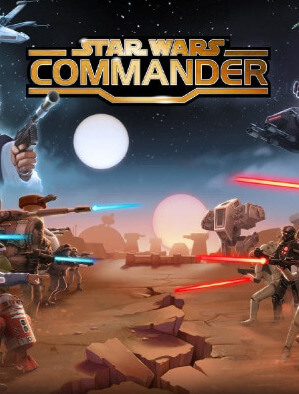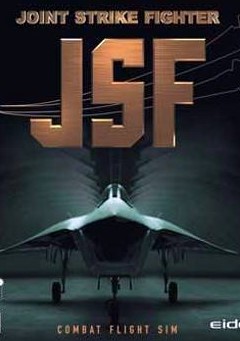Gameplay
After selecting a pilot file, the player views the "concourse", a hub with doors to different features of the game. While the main focus of gameplay is completing battles, the concourse also offers several other areas. The training simulator lets the player fly each of the pilotable Imperial craft through a complex obstacle course. The combat chamber offers four extra missions for each craft, ranging from training scenarios to historical reenactments of important missions. There is also a room to view mission recordings, and a tech room to view information about every spacecraft that appears in the game. When the player selects a mission, he or she is given a briefing, consisting of a dialog describing the mission and an animated map illustrating vessel positions and basic flight patterns. The player may optionally read a list questions and answers about the mission.
In addition to the standard mission briefing covering primary objectives, there is often another briefing given by a mysterious figure who belongs to the Emperor's Inner Circle. This person informs the pilot of optional secondary objectives and provides additional plot information. Completing the primary objectives allows the player to progress to the next mission and earn Imperial military promotion; completing secondary and secret objectives garners additional medals and promotions within the inner circle.
Combat
In-flight gameplay is similar to X-Wing, played primarily in first-person but with the option to switch to third-person. All flight takes place in space; the player does not encounter gravity or atmospheric effects. Mission roles including dogfighting, escorting or disabling other craft, inspecting vehicles, and attacking capital ships and space stations. Initial missions place the player in unshielded TIE fighter variants; as the game progresses, the player gains access to advanced fighters with shields and better armaments.
Laser cannons and ion cannons serve as short range weapons, damaging or disabling targets respectively. Some starfighters carry limited number of missiles or torpedoes for additional range/firepower. As with X-Wing, the player needs to balance power allocation between weapons, engines, and shields (when available); some craft also require the player to further balance power for a beam weapon (a tractor beam which can prevent enemy fighters from maneuvering temporarily, or a jamming beam which can dispute the defensive fire of enemy capital ships). The player can also change the firing modes of his or her fighter's weapons (for example, having a pair of laser cannons fire together or alternately). If the ship possesses shields, the player chooses the shield balance between front and rear.
Shields are rechargeable; they protect from damage but are depleted when absorbing damage. When the player's craft is unshielded, enemy fire will damage the player's hull. Hull damage can disable systems, such as the engines or targeting computer. Disabled systems will slowly be repaired; TIE Fighter allows the player to choose the order in which systems are repaired. Hull damage may also cause cockpit displays to break, rendering them useless for the remainder of the mission. Heavy hull damage will destroy the player's spacecraft. When the player's craft is destroyed before completing a mission, or the mission is otherwise a failure, the player can attempt the mission again. However, the mission is still successful if the player's craft is destroyed after all primary mission objectives are completed.
While based upon X-Wing, TIE Fighter does introduce several gameplay additions that made it less difficult than its predecessor. The targeting system allows players to target capital ships' and space stations' components, such as shield generators and weapons. Additionally, the targeting display shows a 3D model and relative orientation of the player's target. Mission objective status is accessible in-game, as is a log of in-flight messages.
Reception
Gamebytes Magazine gave the original release its "very highest recommendation", citing numerous improvements over X-Wing. The reviewer called the graphics "astonishing" and noted improved artificial intelligence and in-flight information systems. The review's "single complaint" was the lackluster ending. Edge praised many of the graphic and gameplay enhancements and new features over X-Wing, but described the missions as repetitive and complained the game loses appeal when the player isn't fighting for the underdog Rebellion. GameSpot's review of the Collector's CD-ROM Edition called TIE Fighter "the best space combat game ever made" and praised the updated graphics.
Macworld's Michael Gowan summarized TIE Fighter as a "great game" that offers the "action of a World War II dogfight".
Next Generation reviewed the Macintosh version of the game, rating it three stars out of five, and stated that "TIE Fighter, like the movies, isn't really at the cutting edge, but both still offer more depth and considered design than many young razzle-dazzlers."
